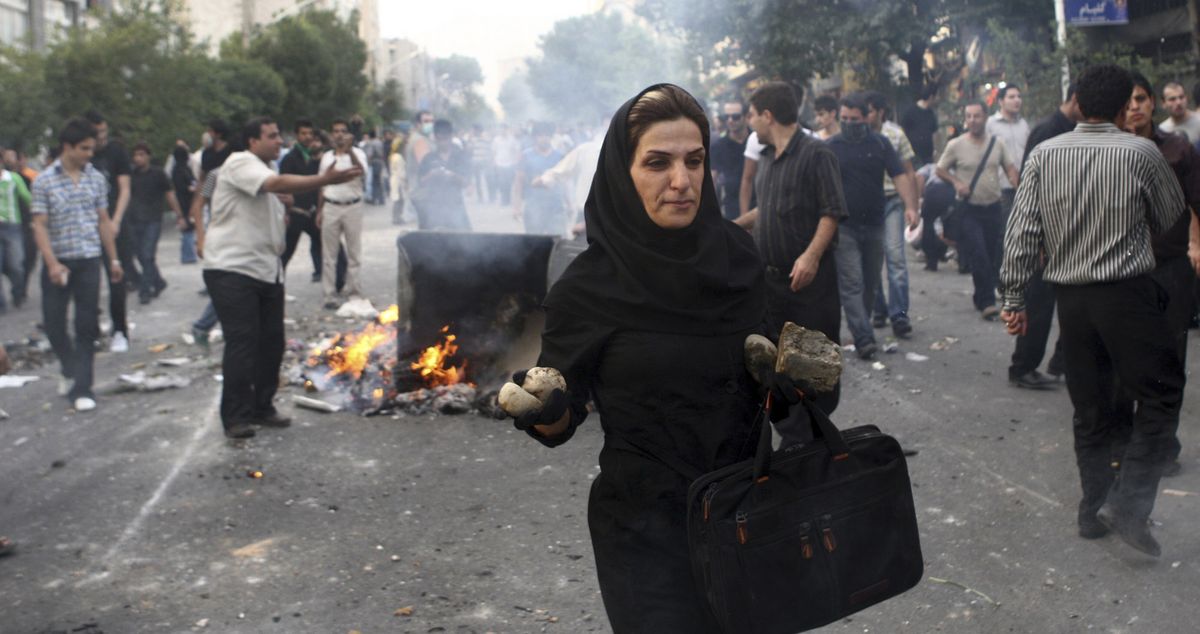Iranian women take historic role in protests

For years, women’s defiance in Iran came in carefully planned flashes of hair under their head scarves, brightly painted fingernails and trendy clothing that could be glimpsed under bulky coats and cloaks.
These small acts of rebellion against the theocratic government have been eclipsed in the wake of the disputed June 12 presidential elections. In their place came images of Iranian women marching alongside men, of their scuffles with burly militiamen, of the sobering footage of a young woman named Neda, blood pouring from her mouth and nose minutes after her fatal shooting.
In a part of the Muslim world where women are often repressed, these images have catapulted Iran’s female demonstrators to the forefront of the country’s opposition movement. It is a role, say Iranian women and experts, that few seem willing to give up, and one that will likely present President Mahmoud Ahmadinejad’s hardline government with even greater challenges in the wake of the recent violence and protests.
“Iranian women are very powerful and they want their freedom,” said one woman in Tehran who said she’s been taking part in the protests. Like all women in Iran interviewed for this story, she did not want to be named, fearing government retribution. “They’re really, really repressed, and they need to talk about it.”
The election seemed to open the floodgates for airing that sense of frustration.
Claims by Ahmadinejad’s chief rival for the presidency, Mir Hossein Mousavi, that the election was riddled with fraud were the catalyst for days of protest following the vote. The government’s harsh response – evidenced in hundreds of arrests, the deaths of more than a dozen demonstrators, clampdowns on the media, the refusal of the country’s theocratic leaders to entertain the possibility of a recount – fueled popular discontent across wide swaths of the population.
But there is an extra layer of resentment and anger among many of Iran’s 35 million women. Many fear that a second term for a man who was first elected in 2005 in part on a platform of restoring “Islamic values” will prove to be worse than the first.
“The root of the current unrest is the people’s dissatisfaction and frustration at their plight going back before the election,” said Iranian Nobel Peace laureate Shirin Ebadi. “Because women are the most dissatisfied people in society, that is why their presence is more prominent.”
While Iranian women have been politically active in the past, coming out in large numbers in support of the 1979 Islamic Revolution, the latest demonstrations showed them standing shoulder-to-shoulder with their male counterparts, enduring the same blows and threats.
“We were all together, and we helped each other despite our sexuality, and we will be together,” said one 34-year-old Tehran woman who is active in the protests.
They have also given the movement some of its most high-profile arrests – former President Hashemi Rasfanjani’s 46-year-old activist daughter – and its first martyr, Neda Agha Soltan. Soltan, who was allegedly shot by pro-government militia as she walked through a protest Saturday, became the public face of the government’s repression – a female martyr in a culture that celebrates such symbols, but usually relegates women to the role of the martyr’s mother or wife. President Barack Obama on Tuesday summed it up as such: “We have seen courageous women stand up to brutality and threats, and we have experienced the searing image of a woman bleeding to death on the streets.”
In the convoluted, and fluid, calculus of Iranian politics, it remains to be seen how the government will deal with these challenges. Also unclear is how these developments will shape policy.
Under previous reformist regimes, Iranian women secured a wink-and-a-nod attitude from the government that allowed them to adopt more casual hair coverings and more freedoms than those seen in other conservative Muslim countries in the region, such as Saudi Arabia.
Although they are barred from the presidency and religious posts, many Iranian women are in parliament and other political offices. About 65 percent of university students are women.
In 2006, a group of women launched a campaign to gather a million signatures in favor of equal rights for women. And, in the run-up to the presidential election, a coalition of women from diverse economic and social classes worked to ensure that the candidates focused their platforms on efforts to improve women’s lives.
Mousavi’s bid for the presidency further encouraged them, with women buoyed in no small part by his progressive stance on women’s issues and his unorthodox – at least for Iran – campaign appearances alongside his wife, Zahra Rahnavard.
On Wednesday, Rahnavard made her voice heard again, saying on one of her husband’s Web sites that his followers had the right to protest and the government should not deal with them harshly.
It remains to be seen how women, particularly after the days of violence, will demonstrate their dissatisfaction with the regime, especially if it’s headed by a man whose earlier actions were seen as limiting their rights.
Under Ahmadinejad’s first term, rules were set in place that made it difficult for women to work late or take on extra hours, and pushing many into part-time jobs. Last year, his government proposed a law that would have made it easier for men to take additional wives – a practice allowed under Islam but generally frowned upon in Iran.
Rules on women’s clothing are tightly enforced under Ahmadinejad. Women are required to cover their hair and wear loose and long garments over pants. They face arrest if their clothing fashion is deemed too risque. “It is the biggest insult to a woman that somebody can tell her what she should wear,” said the 34-year-old Tehran woman active in the protests. “Nowadays many people can see the world easily, how they live peacefully in their countries without any enforcement, so we know our basic rights as a human and especially as a woman.”